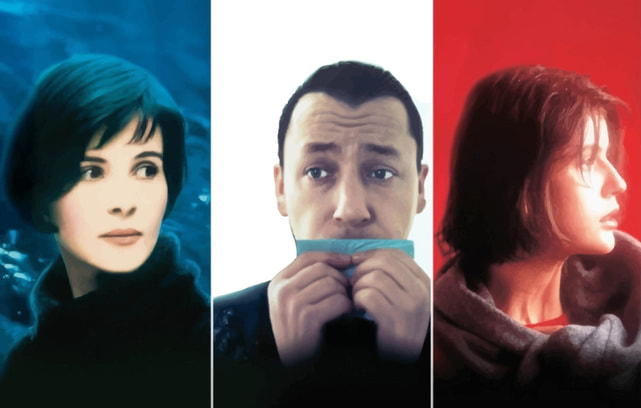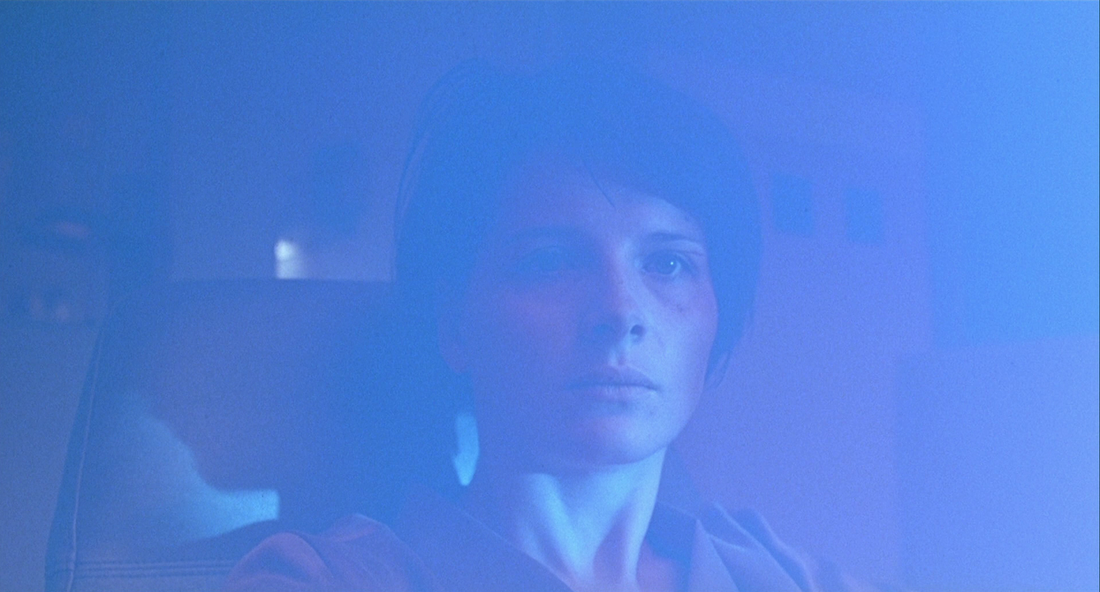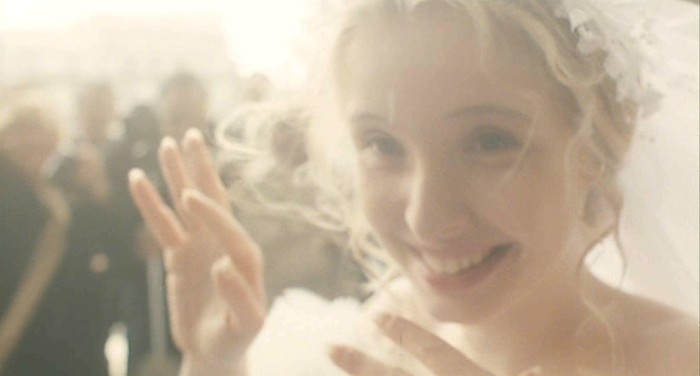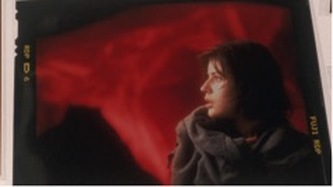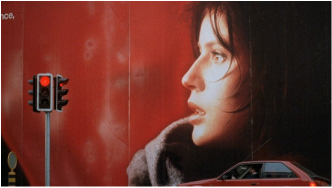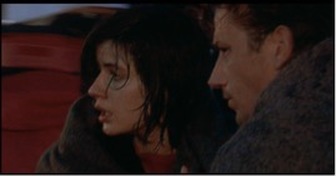The Many Colors of Fate in Krzysztof Kieslowki's Three Colors Trilogy
by Mark Trinkle
In the years 1993 and 1994 Polish director Krzysztof Kieślowski released a trilogy of three films released in English as Three Colors: Blue (1993), Three Colors: White (1994), and Three Colors: Red (1994). The titles of the Three Colors Trilogy were inspired by the three colors of the French flag and loosely correlated to the three ideals included in the French motto ‘liberty, equality, and fraternity.' The trilogy went on to win a total of eight awards at various high profile film festivals, such as the Berlin and Venice film festivals, and also received two Academy award nominations (Haltoff, 122).
The three protagonists shown before the colors of their respective films - from left to right: Julie (Juliette Binoche), Karol (Zbigniew Zamachowski), and Valentine (Irène Jacob).
The Three Colors Trilogy was Kieślowski’s last project before he retired, and together these three films serve as a combination of the best elements of his artistic career. In these films he continued to explore the spiritual and moral complexity that governs human relationships, a topic that he first addressed in his critically successful ten-part series The Decalogue (1988) (which was loosely inspired by the Ten Commandments) (Haltoff, 75). The trilogy also reflected on the strange nature of fate as shown in another one of his films The Double Life of Véronique (1991), which tells the story of two women and their parallel yet interconnected lives (Haltof, 114). Since these themes of transcendent spirituality, complex human relationships and the unfathomable power of fate were so important in Kieślowski’s films, it can be said that the Three Colors Trilogy is in many ways a culmination of both Kieślowski’s vision and talent for creating beautiful yet relatable films.
All three films in the trilogy are perfect examples of art cinema in the way that they visually emphasize emotions and sensations over conventional plot structures. In Kieślowski’s films, “the camera does not reveal, as in his early films, but intrudes, and calls attention to itself through the symbolic, ‘unnatural’ use of colours, camera angles, and lighting” (Haltof, 111). Each film uses these elements, color especially so, to emphasize the themes for which Kieślowski eventually became known: spirituality, relationships and fate. All of the films include elements that refer to each of these themes, but this paper will look specifically at how the use of the three different colors in the trilogy- blue, white and red- helps emphasize a specific concept in their respective films.
In the first film in the trilogy, Blue, Juliette Binoche plays a woman named Julie who loses her husband and child in an accident and tries with little success to cut ties with her past. The film uses the color blue to represent both the overwhelming sadness Julie feels and at the same time the memory of what she has lost. This motif is set up in the first scene of the film while her family is still alive. Her daughter plays with a blue candy wrapper holding it out the car window letting it flap in the breeze in a prolonged credit sequence that ends only moments before the car crashes. Because of this, when the color blue shows up again it is easy for us to recall the emotions of loss in a very poignant and subtle way.
The three protagonists shown before the colors of their respective films - from left to right: Julie (Juliette Binoche), Karol (Zbigniew Zamachowski), and Valentine (Irène Jacob).
The Three Colors Trilogy was Kieślowski’s last project before he retired, and together these three films serve as a combination of the best elements of his artistic career. In these films he continued to explore the spiritual and moral complexity that governs human relationships, a topic that he first addressed in his critically successful ten-part series The Decalogue (1988) (which was loosely inspired by the Ten Commandments) (Haltoff, 75). The trilogy also reflected on the strange nature of fate as shown in another one of his films The Double Life of Véronique (1991), which tells the story of two women and their parallel yet interconnected lives (Haltof, 114). Since these themes of transcendent spirituality, complex human relationships and the unfathomable power of fate were so important in Kieślowski’s films, it can be said that the Three Colors Trilogy is in many ways a culmination of both Kieślowski’s vision and talent for creating beautiful yet relatable films.
All three films in the trilogy are perfect examples of art cinema in the way that they visually emphasize emotions and sensations over conventional plot structures. In Kieślowski’s films, “the camera does not reveal, as in his early films, but intrudes, and calls attention to itself through the symbolic, ‘unnatural’ use of colours, camera angles, and lighting” (Haltof, 111). Each film uses these elements, color especially so, to emphasize the themes for which Kieślowski eventually became known: spirituality, relationships and fate. All of the films include elements that refer to each of these themes, but this paper will look specifically at how the use of the three different colors in the trilogy- blue, white and red- helps emphasize a specific concept in their respective films.
In the first film in the trilogy, Blue, Juliette Binoche plays a woman named Julie who loses her husband and child in an accident and tries with little success to cut ties with her past. The film uses the color blue to represent both the overwhelming sadness Julie feels and at the same time the memory of what she has lost. This motif is set up in the first scene of the film while her family is still alive. Her daughter plays with a blue candy wrapper holding it out the car window letting it flap in the breeze in a prolonged credit sequence that ends only moments before the car crashes. Because of this, when the color blue shows up again it is easy for us to recall the emotions of loss in a very poignant and subtle way.
Not long after the accident, there is a scene where Julie is sitting alone in the hospital when the screen suddenly floods with blue light. This is the first moment where we see this much blue since the beginning sequence and it serves as a startling visual connection to the inexpressible emotions Julie is experiencing regarding her past. These waves of color are accompanied by a swelling music score by Zbigniew Preisner (who wrote the music for many of Kieślowski’s other films). Towards the end of the film, we discover that this piece is Julie’s subconscious mind trying to finish a musical score that she was working on with her husband before he passed away. It is yet another link to the past that she cannot avoid. The most interesting aspect of this scene is that as the screen changes color and the music swells, Julie wakes up and looks directly at the camera as it moves back and forth in front of her, shocked by this unexplainable interference into her psyche. The movement, musical score and color create a sense that something powerful and important is happening. Not only is it beyond her control, but the fact that she is the only one experiencing this strange synesthesia (the audience excluded) reveals that it is something deeply personal and strangely spiritual. It is this kind of a spiritual experience of memory and emotion, both powerful and sad that she tries to avoid during the film as she leaves her life behind and moves to Paris.
None of the other moments in the film that include significant traces of blue are so jarring, but that moment stands out so much because it sets up connections to both the past and the future. Julie eventually comes to terms with her past and decides to finish writing the musical piece that had been haunting her for so long. The sadness that came with the memories of her past life, represented by the color blue, are the thing she must embrace in order to do what she was meant to do and complete the symphony. When the vivid color blue mingled with the score that was not yet written, it was hinting to us- and Julie-that some exterior force was pushing on her life, and it is up to us to decide if that force is destiny, God, mere chance etc. The film is very abstract in the way it presents this implied belief in something transcendent and spiritual, but it does so as a reflection of Kieślowski’s own agnostic beliefs. He rarely spoke definitively about his personal beliefs about the existence or nature of God, merely saying once that “if someone like a God above exists [...] then we very much slip out of his grasp” (Kickasola, 34). Blue doesn’t claim to explain why God allowed the death of Julie’s family, but it does hint at the fact that some spiritual power is present and possibly working in and around her.
In the trilogy's second film, Three Colors: White, Kieślowski tries a less direct approach in his use of color to illustrate his themes of fate, spirituality and interconnectedness. The film follows the story of Karol Karol, played by Zbigniew Zamachowski, whose wife Dominique (Julie Delphy) divorces him because of his sexual impotence and kicks him out on the street. After moving to the countryside and making a small fortune he takes revenge on her by faking his own death and framing her for it. Their relationship is one of both love and hate that makes this ironically titled film a black comedy that portrays human interactions that are complex and far from cliché.
The color white reoccurs at many times in the film, but instead of symbolizing concrete ideas, most of the white that appears seems to have no importance or meaning, appearing on mundane objects such as a toilet, bird droppings, and snow. However, there are two main exceptions in which white clearly indicates something of thematic importance. Throughout the film Karol has several reoccurring flashbacks of a washed out dreamlike memory of his ex-wife on their wedding day. This heavenly glow shows how Karol idealizes her throughout most of the film despite her harsh treatment of him. After he recuperates financially, he comes up with a plan to get both the attention from her that he once desired and the revenge he feels he deserves. After faking his death to see her grieve, thereby proving she still has feelings for him, he sneaks into her hotel room and seduces her. While the two are making love the screen fades to white over the sounds of Dominique’s ecstasy. Immediately after their time together Karol leaves, and Dominique is arrested having been framed for his ‘death.' It is ironic that in manipulating his ex-wife’s affections in such a dark and twisted manner, the color that signifies his ‘victory’ over her is white, a color usually symbolic of purity or goodness.
None of the other moments in the film that include significant traces of blue are so jarring, but that moment stands out so much because it sets up connections to both the past and the future. Julie eventually comes to terms with her past and decides to finish writing the musical piece that had been haunting her for so long. The sadness that came with the memories of her past life, represented by the color blue, are the thing she must embrace in order to do what she was meant to do and complete the symphony. When the vivid color blue mingled with the score that was not yet written, it was hinting to us- and Julie-that some exterior force was pushing on her life, and it is up to us to decide if that force is destiny, God, mere chance etc. The film is very abstract in the way it presents this implied belief in something transcendent and spiritual, but it does so as a reflection of Kieślowski’s own agnostic beliefs. He rarely spoke definitively about his personal beliefs about the existence or nature of God, merely saying once that “if someone like a God above exists [...] then we very much slip out of his grasp” (Kickasola, 34). Blue doesn’t claim to explain why God allowed the death of Julie’s family, but it does hint at the fact that some spiritual power is present and possibly working in and around her.
In the trilogy's second film, Three Colors: White, Kieślowski tries a less direct approach in his use of color to illustrate his themes of fate, spirituality and interconnectedness. The film follows the story of Karol Karol, played by Zbigniew Zamachowski, whose wife Dominique (Julie Delphy) divorces him because of his sexual impotence and kicks him out on the street. After moving to the countryside and making a small fortune he takes revenge on her by faking his own death and framing her for it. Their relationship is one of both love and hate that makes this ironically titled film a black comedy that portrays human interactions that are complex and far from cliché.
The color white reoccurs at many times in the film, but instead of symbolizing concrete ideas, most of the white that appears seems to have no importance or meaning, appearing on mundane objects such as a toilet, bird droppings, and snow. However, there are two main exceptions in which white clearly indicates something of thematic importance. Throughout the film Karol has several reoccurring flashbacks of a washed out dreamlike memory of his ex-wife on their wedding day. This heavenly glow shows how Karol idealizes her throughout most of the film despite her harsh treatment of him. After he recuperates financially, he comes up with a plan to get both the attention from her that he once desired and the revenge he feels he deserves. After faking his death to see her grieve, thereby proving she still has feelings for him, he sneaks into her hotel room and seduces her. While the two are making love the screen fades to white over the sounds of Dominique’s ecstasy. Immediately after their time together Karol leaves, and Dominique is arrested having been framed for his ‘death.' It is ironic that in manipulating his ex-wife’s affections in such a dark and twisted manner, the color that signifies his ‘victory’ over her is white, a color usually symbolic of purity or goodness.
The incredibly ambiguous meaning of the color white in this film may be hard to understand at first, but looking at the ambiguous nature of love in the film's central relationship, we begin to see the point. Geoff Andrew made this connection when he said, “Just as White proffers an account of love as an emotion which may either be blind, cruel, possessive and immature, or warm, curative, transforming and mutually advantageous, so the colour white has a double-edged resonance in the film, evocative of [both]purity and filth” (Andrew, 50). White shows how human relationships can be a complicated web with causes and effects both unpredictable and unfathomable.
The final part of the Three Colors Trilogy, Three Colors: Red, tells the story of a young model named Valentine who runs into a reclusive former judge with whom she strikes up an unusual friendship. Valentine is played by Irène Jacob who had previously worked with Kieślowski when she played the titular character(s) in The Double Life of Véronique. The film intercuts Valentine’s story with that of a young man name Auguste (Jean-Pierre Lorit), whose life reflects in many ways that of the old judge (Jean-Louis Trintignant) when he was young, creating another ‘double life’ between two otherwise unrelated characters. Interestingly enough Auguste lives in the apartment building across from Valentine’s and despite many close calls, they don’t run into each other until the final scene of the film.
Kieślowski once said “I believe fate is an important part of life. [...] Naturally, a person may select his or her path[...] But to understand where you are in the present, it is necessary to retrace the steps of your life and isolate the parts played by necessity, free will and pure chance”(Mitchell,66 ). This theme of powerful cause and effect is clear to see in the story as the film’s namesake color red is clear to see in the mise-en-scene. There are many more colored objects of thematic importance in this film when compared to the other two films, but this film serves to underscore the entire trilogy and the concepts of fate and destiny that are present require a certain amount of overtness in order to prove their point.
There are several scenes when Valentine and Auguste almost meet each other that include some sort of vibrant red in them. For example the restaurant that is underneath Valentine's apartment has a bright red sign, so there a few scenes that pan between the two characters in their respective homes where this red is prominently visible. The repeated use of this bold color creates a sense of urgency, and gives a sense of importance to otherwise mundane occurrences. Of course the repeated instances of missed interaction are frustrating enough for the audience, who assume from classic film convention that the two must get together eventually. But with the presence of red as our visual cue to significant moments we can see the slow and seemingly random ways that fate works: at first keeping them apart and later bringing them together.
The single most memorable image of the film is the photograph of Valentine staring off to the side in front of a red background taken at a photoshoot early in the film. This picture seems insignificant at first, but when it appears again on a billboard at the same red light where Valentine drives past a distracted Auguste earlier in the film, the nature of such a coincidence comes into question. This sense of destined connection is fulfilled at the end of the film when Valentine and Auguste finally meet. They were both traveling on a ferry that crashed in the English Channel and are the only survivors from Switzerland. As we see the news footage of their rescue we see Valentine finally standing near Auguste huddled in a blanket as a man in a red coat passes behind her. This image is an unmistakable parallel to the photograph from earlier, or more precisely, the photograph itself foreshadowed this fateful moment implying that every near miss had led up to this final meeting.
The final part of the Three Colors Trilogy, Three Colors: Red, tells the story of a young model named Valentine who runs into a reclusive former judge with whom she strikes up an unusual friendship. Valentine is played by Irène Jacob who had previously worked with Kieślowski when she played the titular character(s) in The Double Life of Véronique. The film intercuts Valentine’s story with that of a young man name Auguste (Jean-Pierre Lorit), whose life reflects in many ways that of the old judge (Jean-Louis Trintignant) when he was young, creating another ‘double life’ between two otherwise unrelated characters. Interestingly enough Auguste lives in the apartment building across from Valentine’s and despite many close calls, they don’t run into each other until the final scene of the film.
Kieślowski once said “I believe fate is an important part of life. [...] Naturally, a person may select his or her path[...] But to understand where you are in the present, it is necessary to retrace the steps of your life and isolate the parts played by necessity, free will and pure chance”(Mitchell,66 ). This theme of powerful cause and effect is clear to see in the story as the film’s namesake color red is clear to see in the mise-en-scene. There are many more colored objects of thematic importance in this film when compared to the other two films, but this film serves to underscore the entire trilogy and the concepts of fate and destiny that are present require a certain amount of overtness in order to prove their point.
There are several scenes when Valentine and Auguste almost meet each other that include some sort of vibrant red in them. For example the restaurant that is underneath Valentine's apartment has a bright red sign, so there a few scenes that pan between the two characters in their respective homes where this red is prominently visible. The repeated use of this bold color creates a sense of urgency, and gives a sense of importance to otherwise mundane occurrences. Of course the repeated instances of missed interaction are frustrating enough for the audience, who assume from classic film convention that the two must get together eventually. But with the presence of red as our visual cue to significant moments we can see the slow and seemingly random ways that fate works: at first keeping them apart and later bringing them together.
The single most memorable image of the film is the photograph of Valentine staring off to the side in front of a red background taken at a photoshoot early in the film. This picture seems insignificant at first, but when it appears again on a billboard at the same red light where Valentine drives past a distracted Auguste earlier in the film, the nature of such a coincidence comes into question. This sense of destined connection is fulfilled at the end of the film when Valentine and Auguste finally meet. They were both traveling on a ferry that crashed in the English Channel and are the only survivors from Switzerland. As we see the news footage of their rescue we see Valentine finally standing near Auguste huddled in a blanket as a man in a red coat passes behind her. This image is an unmistakable parallel to the photograph from earlier, or more precisely, the photograph itself foreshadowed this fateful moment implying that every near miss had led up to this final meeting.
A picture from Valentine's photoshoot
The billboard of the same photograph
Valentine and Auguste after the ferry accident
This final sequence is masterful on yet another level, because it is the culmination not just of their story but of the entire trilogy. Valentine and Auguste are the only survivors from Geneva, but also rescued from that same ferry ride are Karol and Dominique from White as well as Julie and her lover Olivier from Blue. Not only does it illustrate the unknowable hand of fate, but this final scene restates the themes of interconnectedness and questions the nature of the divine spiritual purpose in such serendipity. This is not a happy ending per se, but we do get the overwhelming sense that everything has been happening for a reason, even if the exact nature of that reason is beyond our understanding or the understanding of the characters. It is a beautiful scene that ties together the previously open-ended nature of the trilogy in a way that restates the universal but not entirely explainable concept of spirituality, relationships and fate.
Works Cited:
Andrew, Geoff. "The 'Three Colors' Trilogy." Film Quarterly 52.4 (1999): 63-64. Web.
Haltof, Marek. The Cinema of Krzysztof Kieślowski: Variations on Destiny and Chance.
New York: Wallflower, 2004. Print.
Kickasola, Joseph G. The Films of Krzysztof Kieślowski: The Liminal Image. New York:
Continuum, 2004. Print.
Kieślowski, Krzysztof, Danusia Stok, and MattiApunen.Kieślowski on Kieślowski. Helsinki:
Like, 2003. Print.
Mitchell, Jolyon P., and S. Brent Plate. "Krzysztof Kieślowski, from the Introduction to
Decalogue: The Ten Commandments (1991)." The Religion and Film Reader.
New York: Routledge, 2007. N. pag. Print.
Works Cited:
Andrew, Geoff. "The 'Three Colors' Trilogy." Film Quarterly 52.4 (1999): 63-64. Web.
Haltof, Marek. The Cinema of Krzysztof Kieślowski: Variations on Destiny and Chance.
New York: Wallflower, 2004. Print.
Kickasola, Joseph G. The Films of Krzysztof Kieślowski: The Liminal Image. New York:
Continuum, 2004. Print.
Kieślowski, Krzysztof, Danusia Stok, and MattiApunen.Kieślowski on Kieślowski. Helsinki:
Like, 2003. Print.
Mitchell, Jolyon P., and S. Brent Plate. "Krzysztof Kieślowski, from the Introduction to
Decalogue: The Ten Commandments (1991)." The Religion and Film Reader.
New York: Routledge, 2007. N. pag. Print.

